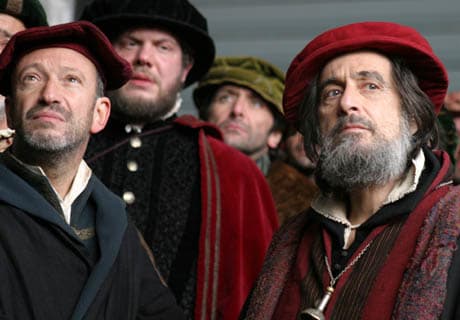William Shakespeare once again finds his work at the local multiplex with this sumptuous adaptation of one of his trickier famous plays. And while it's a lovely film to watch, beautifully made, well-designed and acted by a cast of the notably accomplished, it remains a wonder why anyone felt truly compelled to make the film at all. Michael Radford follows up his Oscar-nominated Il Postino with this sumptuous period adaptation, most notable for Al Pacino's bravura performance in the lynchpin performance as Shylock.
The action is well-known to any high school English student: smitten Bassanio (Joseph Fiennes, returning to Shakespeare after some absence) wants to woo beautiful Portia (newcomer Lynn Collins) but has no cash to finance his courtship. He turns to his rich merchant friend Antonio (Jeremy Irons) who has the means but whose cash flow is currently tied up in various import/export projects; no worries though, Antonio simply borrows the cash from local money lender Shylock (Pacino) on the promise that non-payment would result in Shylock's taking a pound of flesh from Antonio.
To adapt The Merchant of Venice is to deal with "the Jewish problem." In 15th century Europe, only the Jewish population was allowed to deal in lending money at interest and that, only because they were not allowed to own property. Thus the issues of Merchant of Venice of commerce and of law are issues that surround the treatment of the Jewish population. The play has been considered by many to be anti-Semitic, furthering Jewish stereotypes as money-grubbing, or at least as more financially self-interested than other ethic groups. Thus the adaptation of the play deals primarily with a dance of political choices regarding Shylock and his portrayal.
To his credit, Radford does a fine job of showcasing the "new school" Shylock, where his treatment has been so brutal, and his quest for justice so hampered, that his demand for proper payment, according to the letter of his agreement with Antonio, seems like a demand for justice by all Jews and not the selfish revenge of an embittered old man. But beyond Shylock who is after all merely part of the action of the play Merchant titters along nicely through the courtship of Portia, where suitors must choose one of three boxes (gold, silver and lead), only one of which will reward the suitor with her hand.
This version of The Merchant of Venice one of more than a dozen filmed adaptations does a perfectly reasonable job of envisioning its 15th century setting. Costuming, cinematography and acting are all top-notch, as one would expect from any team putting together such a big-budget adaptation. But unlike, say Baz Luhrmann's 1996 revisioning of Romeo + Juliet, which toyed with both time and setting, The Merchant of Venice is simply a high-gloss production of a time-worn play, nothing more. (Mongrel Media)
The action is well-known to any high school English student: smitten Bassanio (Joseph Fiennes, returning to Shakespeare after some absence) wants to woo beautiful Portia (newcomer Lynn Collins) but has no cash to finance his courtship. He turns to his rich merchant friend Antonio (Jeremy Irons) who has the means but whose cash flow is currently tied up in various import/export projects; no worries though, Antonio simply borrows the cash from local money lender Shylock (Pacino) on the promise that non-payment would result in Shylock's taking a pound of flesh from Antonio.
To adapt The Merchant of Venice is to deal with "the Jewish problem." In 15th century Europe, only the Jewish population was allowed to deal in lending money at interest and that, only because they were not allowed to own property. Thus the issues of Merchant of Venice of commerce and of law are issues that surround the treatment of the Jewish population. The play has been considered by many to be anti-Semitic, furthering Jewish stereotypes as money-grubbing, or at least as more financially self-interested than other ethic groups. Thus the adaptation of the play deals primarily with a dance of political choices regarding Shylock and his portrayal.
To his credit, Radford does a fine job of showcasing the "new school" Shylock, where his treatment has been so brutal, and his quest for justice so hampered, that his demand for proper payment, according to the letter of his agreement with Antonio, seems like a demand for justice by all Jews and not the selfish revenge of an embittered old man. But beyond Shylock who is after all merely part of the action of the play Merchant titters along nicely through the courtship of Portia, where suitors must choose one of three boxes (gold, silver and lead), only one of which will reward the suitor with her hand.
This version of The Merchant of Venice one of more than a dozen filmed adaptations does a perfectly reasonable job of envisioning its 15th century setting. Costuming, cinematography and acting are all top-notch, as one would expect from any team putting together such a big-budget adaptation. But unlike, say Baz Luhrmann's 1996 revisioning of Romeo + Juliet, which toyed with both time and setting, The Merchant of Venice is simply a high-gloss production of a time-worn play, nothing more. (Mongrel Media)




